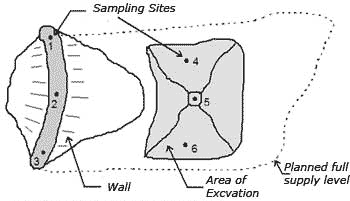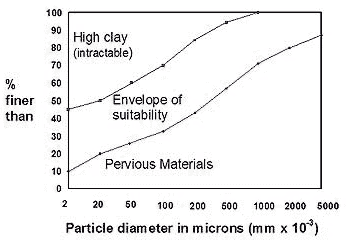Soil materials for farm dam construction
A failed dam is not only a waste of effort — it loses future income and security.
The quantity and suitability of soil materials at a dam site can only be reliably determined by test digging with an auger, back-hoe or excavator. The materials can then be properly seen and evaluated. Find out about:
- how to access materials
- how to evaluate materials
- strengths and weaknesses of various materials
General requirements
In assessing material at a potential site consider the following questions:
- What range of materials is available?
- Are there suitable materials available?
- Is there sufficient material for construction requirements?
- Are there potential site weaknesses associated with layers of naturally occurring materials?
Ideal soil
The follow soil characteristics are ideal:
- more than 10% clay
- more than 20% silt plus clay
- sands and gravels in reasonable quantity to supply structural strength
- clay with moderate dispersion — some dispersion is needed to have sufficient mobility to help seal pores without causing tunnelling
- low shrink or swell capacity — as compacted earth materials do wet and dry on a regular basis, low shrink or swell means that potential for shrinkage cracks developing is low
- negligible organic matter content
Problem materials
Problem materials are those with any of the following characteristics:
- low clay content
- high gravel content
- susceptibility to tunnelling (highly dispersive clay)
- strongly flocculated clay well-structured clay behaving somewhat like gravel in terms of permeability
- high shrink or swell capacity (linear shrinkage greater than 15%)
- organic material greater than about 0.5% — from a construction point of view organic material is unstable and not suitable for construction of earth
Field survey and sampling
Field survey is done to look at available soil materials in terms of:
- range
- quality
- quantity
This is an exercise in 3 dimensional mapping of the subsoil. It is needed to find out if:
- suitable materials are available to build the wall
- the underlying materials will support the wall and retain water in the excavation
A logical test-digging pattern is needed to do this. Plan on about 6 locations for a medium sized stock dam (see Figure 1). An auger could be used for each. Alternatively a back-hoe or excavator could be used to trench across groups.

Dig under the centre-line of the proposed wall, as well as sample within the area of the excavation.
When digging under the centre-line of the proposed wall — the holes should go into either rock, or about 600mm into solid, dense clay. If the dam will be a tank (on a flat site) there is no need to dig outside the area of proposed excavation.
When digging into the proposed excavation, the holes should either go down to rock, or to about 600mm below the proposed depth of excavation.
Spread out materials from each of the locations on a plastic sheet and in order of increasing depth.
Look at the range of materials spread out on the sheet and the depth from which they came. Observe similarities between exposed materials at different holes. Record results.
Do a preliminary evaluation:
- How many different materials are there?
- Are there materials with enough 'fines' to make them 'mouldable' when moist?
- Are there sand or gravel seams?
- What quantities (approximately) are there?
- Is there suitable material below the proposed centreline of the wall to 'bed-in' the core trench?
- Are there gravel or sand seams below the site?
Assessing soil characteristics
In many cases, experience and local knowledge will allow an immediate assessment of soil materials. However unfamiliar, unknown or suspicious materials need to be looked at carefully. If there are still doubts, then materials should be forwarded to a laboratory.
Particle size distribution

Soil is composed of various sized mineral particles ranging from coarse (gravel) to very fine (clay) with sand and silt in the intermediate size range. The way these are able to fit and pack together will determine both the structural strength and the permeability of any earth wall.
While it is not possible to get a detailed measure of the particle sizes occurring in a soil without a laboratory analysis — field evaluation can give useful planning information.
A kitchen sieve (with ~2mm apertures) can initially can be used to separate gravel from the 'fine earth'. Make a note of the relative proportions.
The coarse material gives structural strength. The fine earth fills the spaces between the coarse materials. Clay content and its characteristics will determine much of the behaviour of the dam.
The quantity of clay and silt can be roughly assessed by working out how plastic and mouldable the fine earth is when worked into a moist ball. Take a tablespoon of soil in the palm of your hand and work it with water added from a spray bottle until it reaches the consistency of warm plasticine. If the ball holds together and will ribbon moderately between the thumb and the forefinger — there should be enough fines to enable compaction to produce a reasonably water-tight structure.
Dispersion testing
Too much or too little dispersion in dam construction materials is not ideal:
- Dry soils that spontaneously disperse in a glass of fresh water (within two hours) are likely to be tunnel prone and will need to be treated carefully to avoid dam failure.
- Soils that will not disperse even after working when saturated (vigorously shaken in a jar of water and left for 10 minutes) are going to be difficult to make watertight.
Soils which do not spontaneously disperse, but disperse after working when moist, have the best dispersive characteristics for dam construction.
Linear shrinkage
A soil which markedly shrinks on drying will tend to crack and produce lines of weakness.
The potential for shrinkage can be estimated by working the fine earth into a fairly wet state (to a moisture content which causes the soil to behave a bit like whipped cream) using a spatula and a spray bottle, and then making an approximately 200mm long mould (using a vaselined 12mm diameter split PVC pipe). Then allow it to slowly dry out.
The linear shrinkage (LS) can then be estimated from the following relationship:
LS = Lw− Ld divided by Lw× 100
Where: Lw= Length of wet soil
Where: Ld = Length of dry soil
If:
0 − 12% then Low LS
12 − 22% then Medium LS
>22% then High LS
Unified soil classification
Engineers classify soils in terms of the Unified Soil Classification. It groups soils in terms of their expected engineering behaviour. The grouping is made in terms of:
- particle size distribution
- plasticity of the 'fines'
- organic matter content.
The Unified Soil Classification groupings most suitable for farm dam construction are:
CL: Inorganic clays of low to medium plasticity, gravelly clays, sandy clays, silty clays and lean clays.
SC: Clayey sands, poorly graded sand-clay mixtures.
GC: Clayey gravels, poorly graded gravel-sand-clay mixtures
Construction recommendations
The NSW Soil Conservation Service (as it was) developed an evaluation system for farm dams (see chapter 20 of Charman & Murphy, 1991). They base their recommendations on:
- unified soil classification
- level of dispersion
- linear shrinkage.
In essence they recognise 4 broad groupings of material with various degrees of strengths or weaknesses associated with them.
Pervious material
- Where material has less than 10% clay or less than 20% silt plus clay.
- Not recommended for use except as support material in a zoned wall.
- Bentonite clay may be added to effect a seal.
Generally suitable materials
These are materials with suitable characteristics as outlined. Depending on the specific characteristics, the construction recommendation would be to compaction well at an appropriate moisture content.
Tunnel prone materials
These are materials with highly dispersive clays.
Where they have high gravel contents or high linear shrinkages there needs to be very stringent construction methods if they are to be successfully used. These include:
- minimising water stored above the natural surface
- to build and compact at the optimum moisture content
- to compact well and thoroughly
- adding fine grained gypsum on upstream face of the wall to reduce the risk of tunnels forming
- adhering to recommended batter grades
- increasing freeboard to prevent cracks extending below the waterline.
Flocculated (aggregated) materials
Where the clay is strongly flocculated it is hard to effect a seal. Pores tend to remain stable and open to the passage of water.
Such materials need to be compacted slightly wet of optimum. A vibrating roller is likely to be more useful that a static roller.
In most cases, use of a clay dispersing agent (ie sodium tri-polyphosphate) is recommended to decrease the risk of excessive seepage.
Definitions
Dispersion: This occurs when clay particles are able to move about freely (in water) because they are not bound to other clay particles or to organic matter.
Strongly dispersive soil will produce a milky cloud (halo) around an air-dry soil aggregate (pea sized) when placed in a jar of fresh water. This may occur within minutes or take up to two hours. Such materials are tunnel prone.
Moderately dispersive soil will only produces such a cloud when worked in a moist condition before being immersed in water.
Flocculation: This is the opposite of dispersion. The clay particles instead of moving about independently in water — bind readily to one another and settle (flocculate). Such materials are not prone to tunnelling.
Fine earth: Soil material with all particles greater than 2mm in diameter removed.
Mouldable soil: Soil which coheres when worked in a moist state. Clay soils will cohere strongly. Sandy soils tend to fall apart.
Particle size: Measured as the diameter of the particle. Sizes in soil are grouped as followed of:
- clay greater than 2 micron (0.002mm)
- silt 2 to 20 micron
- fine sand 20 to 200 micron
- coarse sand 200 to 2000 micron.
Permeability: Rate at which water will move through soil material.
Plasticity: A measure of mouldability of soil.
Slaking: The physical disruption of soil into fine aggregates when air dry soil is rapidly saturated by raindrops or immersed directly in water. The fine aggregates are considerably larger than clay size and the 2 processes are quite different and should not be confused.
References
Charman P & Murphy B. (1991) Soils: their properties and management. Soil Conservation Service & Sydney University Press. (see Chapter 20)
Emerson W.W. (1977) Physical Properties and Structure in Russell J S & Greacen EL (Eds) Soil Factors in crop production in a semi arid environment, University of Queensland Press.
More information
Your local water authority is able to supply additional information.
Contact consultants with local experience.
Many earth-moving contractors have a wide range of practical experience.